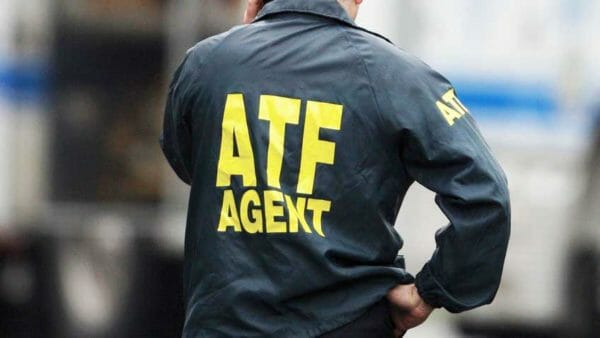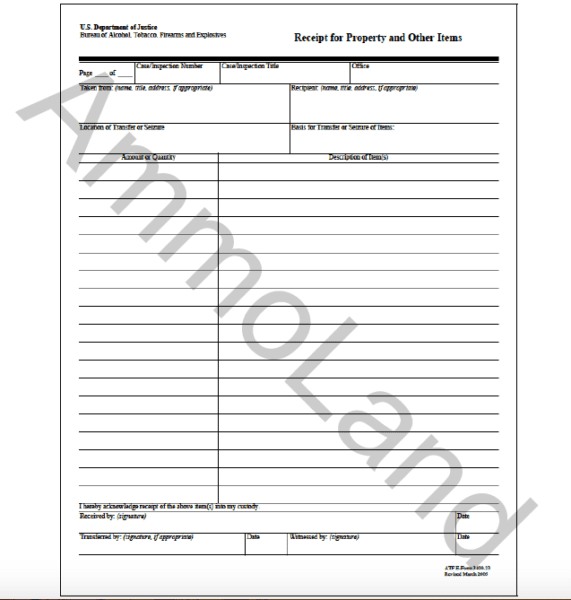
MARTINSBURG, WV –-(Ammoland.com)- For the second part of AmmoLand’s and Gun Owners of America’s joint project to shed light on the inner workings of the Bureau of Alcohol, Tobacco, Firearms and Explosives (ATF) Firearms and Ammunition Technology Division (FATD), we will look at how the division handles and processes evidence in criminal cases.
Gun Owners of America received an unredacted FOIA response with the FATD standard operating procedures (SOP). One of the received SOPs is titled “Evidence Handling and Processing.” That SOP deals with how the Firearms Technology Branch (FTB) approaches to evidence in criminal cases. Having a copy of this SOP can help criminal defense attorneys defend their clients against criminal prosecutions since FATD is the group that determines if a firearm breaks federal law. FATD officers are experts in federal law in the eyes of the government and court system.
Firearms Enforcement Specialist (FES) is a FATD officer assigned to handle criminal evidence when it arrives at the FTB.
The FES is the person that logs in the evidence before it is examined by the Firearms Enforcement Officers (FEOs). The evidence can originate from cases on the federal or state level. The FES could find themselves in control of evidence submitted by the FBI of a local Sheriff’s Department.
The chain of custody is critical to the FES’s job, and that chain is laid out in the Evidence Handling and Processing SOP. The evidence in a criminal case is sent to the FATD officer through common couriers (UPS, USPS, FedEx) to the ATF mailroom in Martinsburg, WV. The mailroom will notify the FES that the evidence has arrived and is ready for pick up. The FES will go to the mailroom and sign out the evidence. From here, FTB assumes control of the received items.
Suppose the ATF is investigating the criminal case tied to the evidence themselves. In that case, there is a chance that the evidence could be hand-delivered to the Martinsburg, WV facility by an ATF agent. The evidence should be accompanied by an ATF F 3311.3. The FES will act as the representative of the FTB when meeting with the ATF agent delivering the evidence. He will draw a line under the last item on the list then date stamp the document. At this time, FTB has assumed custody of the evidence.

The FES will inspect the box that the evidence arrived in for damage. The officer will photograph the box and the shipping label. The photos will be placed with the Evidence Transmittal Form. The ATF cannot assure the chain of custody when evidence is mailed, so they rely on examining the labels and boxes for signs of tampering (This will become important later in the article).
If a firearm arrives loaded, the FES will notify the FTB Branch Chief. The FES will render the firearm safe by following standard safety procedures. After the ATF employee verifies that the gun is now rendered safe and “insert a yellow chamber checker flag or a zip tie into the barrel of the firearm to indicate that the weapon has been rendered safe.”
The FES will assign the evidence an internal FTB tracking number. The employee handling the item will write the FTB tracking number on the Evidence Transmittal Form, the shipping label, and on the outside of the box that the ATF will use to store the firearm. The FES will seal the box and place it in the secure evidence staging area. The employee will log the received item into the FTB electronic evidence database and FTB evidence log. They then will search to see if an FEO has worked on the case number. If the FES can locate an FEO that is currently working the case, then the FES will assign the examination of the firearm to that FEO. If it is determined that no FEO worked on the case, then the FES will assign the examination the next FEO on the rotation.
The FES will place the Evidence Transmittal Form, incoming shipping label, ATF E-Form 3400.23 Receipt of Property (if hand-delivered from an ATF agent) and any other documentation from the case into an orange case folder. If the case is expedited, the FES will place the orange folder into a yellow folder and hand-deliver everything to the FEO. If the case isn’t expedited, the FES will deliver the orange folder and leave the evidence in the staging area.
The FES must complete all logging in of evidence before handing the items over to the FEO to start the examination. An FEO wields immense power that can be used to put someone away for life. An FEO recently determined that the Auto Key Card is a machine gun, and now the company’s owner is facing hundreds of charges, and life has been destroyed. We will explore the examination of various types of evidence as this series continues.
If the FES needs to ship the evidence to a laboratory, then the FES will ship the evidence via a common or contract carrier. The only requirement is that the FES uses a service with a tracking number, mark the shipping label in the ledger with a red marker, and checks the tracking number daily to ensure the package arrives where it is supposed to be. Some experts might think that the type of shipment that the FTD uses breaks the chain of custody, but the ATF doesn’t seem to agree with the assertion.
If the evidence is meant for another department, the FES will determine if they can reuse the same shipping box. The FES will repack the evidence in a new box and ship it out if they can’t. If boxes can be reused, how can anyone determine if a package has been tampered with by a third party? It could be that an ATF employee just decided to reuse the original box.
The next article well will explore how the FEO examines the evidence in criminal cases.
About John Crump
John is a NRA instructor and a constitutional activist. John has written about firearms, interviewed people of all walks of life, and on the Constitution. John lives in Northern Virginia with his wife and sons and can be followed on Twitter at @crumpyss, or at www.crumpy.com.

The post GOA FOIA Shows The Inner Workings of The ATF’s Evidence Handling appeared first on AmmoLand.com.
from https://ift.tt/3CEFQmV
via IFTTT

No comments:
Post a Comment